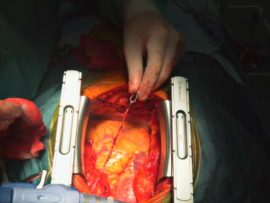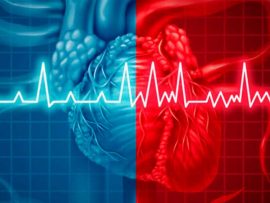Abstract Objectives: Pao2/Fio2 is used commonly for diagnosis of lung injury (acute respiratory distress syndrome and transfusion-related acute lung injury), for assessment of pulmonary disease course and therapy, and in pulmonary..
Read MoreAbstract Background: We sought to determine whether the introduction of a new anticoagulation protocol improved the frequency with which target anticoagulation parameters were met in children supported with extracorporeal membrane..
Read MoreAbstract Background Moderate (MHCA) versus deep (DHCA) hypothermia for circulatory arrest in has been purported to reduce and bleeding complications, although there are limited data supporting this claim. This study aimed to..
Read MoreAbstract Purpose Hemorrhage is the most common cause of preventable death after trauma. Coagulopathy plays a central role in uncontrolled bleeding and is caused by multiple factors. Extracorporeal Membrane Oxygenation..
Read MoreAbstract Background To identify novel factors associated with the survival of septic adults receiving (ECMO) to improve patient selection and outcomes. Methods Cases were identified from our ECMO registry from 2001..
Read MoreAbstract Aim: We sought to quantify the location and volume of thrombus in used hollow-fiber membrane oxygenators and correlate the volume of thrombus with patient demographics, flow characteristics and anticoagulation..
Read MoreAbstract Background Cardiac arrest caused by accidental hypothermia is a rare phenomenon with a significant mortality rate if untreated. The consensus is that these patients should be rewarmed with extracorporeal..
Read MoreAbstract Cardiopulmonary AG, Rastatt, Germany) can be effective in patients requiring venovenous extracorporeal membrane oxygenation (VV-ECMO) for adult respiratory distress syndrome (ARDS). Proper placement of the cannula is important in..
Read MoreAbstract Nosocomial blood stream infections (BSIs) increase both the morbidity and the mortality of patients receiving extracorporeal life support (ECLS). The aim of this study was to identify common practices..
Read MoreAbstract Background There is recent evidence to show that patients suffering from acute kidney injury are at increased risk of developing chronic kidney disease despite the fact that surviving tubular..
Read MoreDespite improvements in percutaneous coronary artery intervention (PCI), coronary artery bypass grafting (CABG) remains the gold standard therapy for the majority of patients with multivessel coronary artery disease. This..
Read MoreAbstract Perioperative myocardial infarction represents the most common cardiovascular complication following non-cardiac surgery, but frequently presents without the usual clinical signs and symptoms consistent with acute coronary syndrome. Given the..
Read MoreAbstract This retrospective, observational study compared the impact of a point-of-care rotational thromboelastometry (ROTEM®) method versus conventional bleeding management in terms of postoperative (24-h) blood loss, intraoperative and postoperative (24-h)..
Read MoreAbstract OBJECTIVES No guidelines for mechanical circulatory support in patients with therapy-refractory cardiogenic shock and multiorgan failure including ongoing cardiopulmonary resuscitation (CPR) exist. To achieve immediate cardiopulmonary stabilization, we established..
Read MoreAbstract Despite a rise in blood pressure, cerebral oxygenation decreases following phenylephrine administration, and we hypothesised that phenylephrine reduces cerebral oxygenation by activating cerebral α1 receptors. We studied patients on cardiopulmonary..
Read MoreAbstract Oxygen is vital for life-sustaining aerobic respiration in humans and is arguably the most commonly administered drug in anaesthesia and critical care medicine. Within the mitochondrial inner membrane, oxygen..
Read MoreAbstract Purpose Cardiopulmonary bypass induces an ischaemia–reperfusion injury and systemic inflammatory response, which contributes to low cardiac output syndrome following cardiac surgery. Exogenous nitric oxide during cardiopulmonary bypass has shown..
Read MoreAbstract Objectives Prolonged after cardiac surgery imposes a significant burden on the patient in terms of morbidity as well as a financial burden on the hospital. We undertook a retrospective analysis..
Read MoreAbstract Background Despite advances in cardiopulmonary resuscitation, functional survival remains low after (OOHCA). (IABP) therapy has recently been shown to augment cerebral blood flow. Whether therapy in the post-resuscitation period improves functional outcomes..
Read MoreAbstract Introduction: Intestinal fatty acid-binding protein (I-FABP) is increasingly employed as a highly specific marker of intestinal necrosis. However, the value of this marker associated with cardiovascular surgery with hypothermic..
Read MoreAbstract The extent and technique of resection for ascending aortopathies remains debated. The 2 main camps are divided into those who believe in the hemiarch resection utilizing hypothermic circulatory arrest..
Read MoreAbstract Background Post–cardiac surgery pulmonary dysfunction may be underreported. Therefore, we evaluated associated risk factors for prolonged pulmonary support after cardiac surgery. Methods and materials We conducted a retrospective, observational..
Read MoreAbstract Objective Concerns regarding pollution of the operating room by and effects on atmospheric ozone depletion exist. commonly are used during to provide independent of any supposed myocardial protective effects. The authors’ aim was..
Read MoreAbstract Objectives: Platelet dysfunction is an important cause of postoperative bleeding after cardiac surgery. Protamine is routinely used for reversal of heparin after cardiopulmonary bypass (CBP), but may affect platelet..
Read MoreAbstract Background This retrospective single-center study aimed to analyze transfusion requirements, coagulation parameters, and outcome parameters in patients undergoing lung transplantation (LuTx) with intraoperative extracorporeal circulatory support, comparing cardiopulmonary bypass..
Read MoreAbstract Background People with atrial fibrillation (AF) often undergo cardiac surgery for other underlying reasons and are frequently offered concomitant AF surgery to reduce the frequency of short‐ and long‐term..
Read MoreAbstract Purpose: To compare characteristics and outcome in children undergoing extracorporeal life support initiated in an extracorporeal life support center or at the patient’s bedside in a local hospital, by..
Read MoreAbstract This observational study aimed to investigate the relationship between renal injury, endothelial function and oxidative stress in claudicants undergoing maximal treadmill exercise. Twenty patients with claudication were identified in..
Read MoreAbstract Objective: To investigate whether human serum albumin coating before cardiopulmonary bypass (CPB) could improve platelet function and hemostasis and mitigate the inflammatory response among patients receiving aortic arch replacement..
Read More













